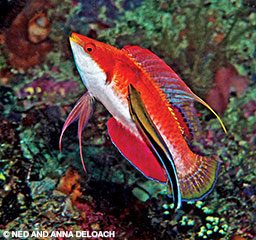Bluestreak cleaner wrasses
Like the woods, which host a hidden menagerie of chiggers and ticks, the clear waters bathing tropical reefs teem with cryptic blood-sucking parasites. The ocean’s micropredators — primarily gnathiid isopod larvae — emerge from the seafloor throughout the day, but the greatest number appear at dawn and dusk. Their all-consuming mission is to quickly engorge with the fish blood required to fuel the next metamorphosis in their multistage lives.
To relieve their pervasive infestations, fish (referred to as clients) frequent patches of reefs manned by small species of fish and shrimp that are specifically adapted for dining on the pests. The behavior, known as cleaning, has long been touted as a classic example of symbiotic mutualism, where two species benefit from a close relationship. A growing library of lab and field experiments published during previous decades has revealed, however, that this once clear-cut example of cooperation is actually rife with conflict and high-stakes drama driven by a single overriding dilemma: Given the choice, cleaners prefer to cheat by taking painful nips of delectable mucus, scales and flesh from clients rather than nibbling crunchy crustacean carapaces. This enticing conundrum has lured scientists deep into the abstract realms of market theory, reciprocal altruism and game theory models, including the much-iterated prisoner’s dilemma, in an attempt to better understand the evolutionary origins of cooperation. But most gratifying for divers is that the steady flow of research has begun to unravel the inner workings of a favorite bit of underwater theater.

The majority of the studies have involved the bluestreak cleaner wrasse (Labroides dimidiatus), the most ubiquitous cleaner in the Indo-Pacific. These finger-sized fish with bold, contrasting stripes typically occupy cleaning stations in male–female pairs with an occasional juvenile or two consigned to the nearby shadows. Numbers from the Great Barrier Reef are astounding, illustrating the magnitude and significance of the cleaning process to coral ecosystems. Bluestreaks stay busy and can have more than 2,000 client/cleaner interactions each day, consuming around 1,200 parasites in the process. One experiment exploring the effects of cleaners on infestation rates documented a fourfold increase in gnathiids on a caged fish denied the services of cleaners for 12 hours.

Even turtles take time out for an occasional cleaning.
Researchers have learned plenty about the gnathiid larvae as well — most surprisingly, at times it takes as little as 30 minutes for the parasites to draw down a gut full of blood before heading home to molt. Such a rapid turnover helps explain why one rabbitfish was documented visiting a cleaning station 144 times during a single day. Most interactions between cleaners and clients last only seconds, while others continue for minutes. To increase their chance of survival during stopovers at cleaning stations, larvae prefer attaching to the blood-rich lining inside a fish’s mouth or gills, where they can feed fast. But most pests end up wedged beneath scales or clamped to fin rays in easy reach of hungry mouths.
Over their long relationship, lines of communication have evolved between bluestreaks and clients. Cleaners advertise their enthusiasm to feed with eye-catching dances, while clients strike pronounced head-up or head-down poses with fins spread, mouths open and gill covers flared to announce their interest in being cleaned. At times, species such as grouper and goatfish flush red to better expose the location of the tiny translucent bloodsuckers.

In market systems where cleaners and clients have the option of cooperating, cheating or defecting, not everyone is treated the same. Even though cleaners enjoy a semblance of immunity from being eaten, bluestreaks obtain an extra layer of protection by applying tactile stimulation across the backs of predatory clients with flurries of fins. The calming strokes, proven to lower stress by raising a fish’s cortisol level has evolved, like intra- and interspecies communication, into an essential tool for balancing social demands such as enticing heavily infested clients to hang around for prolonged inspections.
But most intriguing is that when bluestreaks breach mutualistic etiquette by taking painful bites, customers deal with the outrage in different ways. Large roving species, with ready access to multiple cleaning options, simply take their business elsewhere. On the other hand, small captive customers with no other place to go impulsively chase the greedy parties with punitive nips. It appears that cleaners have good memories and are able to keep 100 clients sorted out in their heads at any given time. When recently duped clients return for service, the offending bluestreaks make sure to bestow generous tactile considerations as tokens of appeasement. This ongoing manipulative interplay keeps souls soothed, parasites picked and everyone in the neighborhood a little more laid back. The study of bluestreak behavior continues. A recent lab experiment using a classic test of self-awareness determined that the remarkable fish are able to recognize themselves in mirrors — the select domain of only a few animals, including us.
© Alert Diver — Q1 2019